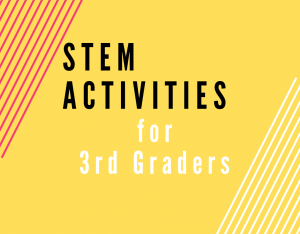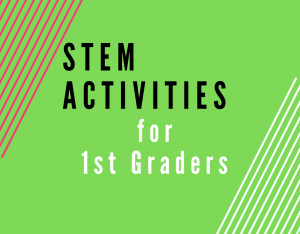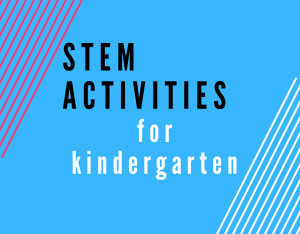Finding STEM activities for sixth graders can be difficult, mainly because STEM is pretty new. Some STEM activity resources do not provide enough information, while others have so much information that it gets confusing. Resources that don’t give enough info usually require you to figure out the rest hoping it’ll turn out OK. The resources with too much information usually try to point out all the teaching standards covered for a span of grades. This makes activities seem more tedious then they have to be, and leaves you to think twice about implementing them.
To simplify things, I created this page to include projects that aren’t too difficult to facilitate, but still useful in advancing STEM learning for sixth graders. Each activity includes a materials list, a description, STEM content, and what to say and ask.
Table of Contents
Copperplating
Materials
- metal paper clips
- water
- scouring pad
- baking soda
- lemon juice
- white/clear vinegar
- salt
- aluminum bolts
- iron nails or screws
- hundreds of dirty pennies, euros, or other materials with high copper surface content
- glass jars
- other non-valuable metal objects students can experiment with
Description
This STEM activity introduces sixth graders to the process of plating one metallic object with another metal and shows the importance of this process in engineering applications. Students come up with strategies to use pennies and a vinegar solution to copperplate other metal objects. Students share their strategies with the class then revise their plans to test how effective they are.
The way it works is when the surface copper of pennies dissolves in the vinegar solution, it coats the iron materials with copper. Copper atoms leave some of their electrons behind when they leave the penny, making positively charged copper ions (copper atoms that are missing two electrons). The same thing happens with iron materials. Positively charged iron ions float in solution with the positively charged copper ions. The iron item becomes negatively charged when the iron ions leave, so it attracts the positively charged ions in solution. The positively charged copper ions are more strongly attracted to the now negatively charged iron item than the iron atoms, so they coat the iron item with a thin coating of copper.
How To
- Have students create the solution by putting 25 old pennies into a glass jar with 1/2 cup (125 ml) of white vinegar and 1/4 teaspoon (1ml) of salt. After 5 minutes, add a non-galvanized iron nail, screw, or other item. Make sure to clear the iron item first by using a sponge with baking soda on it, or scrub with a steel wool pad, so the surface is exposed. Let iron items and pennies soak for 15 minutes. Pennies should be shiny, and the nail should have a thin coating of copper.
- Have students determine two methods for copper plating and identify their items. They may wish to consider placing more than one item in one of the solutions, but you should warn them that any copper released from the pennies or other copper-based coins they have will then be diluted between multiple metal items, so they may not see results. In the box below, have students describe their solution, method, timing, and the items they will copper plate.
- Have students present their plan and anticipated outcome to the class. They may consider the ideas of the other students and adjust their plan if they like.
- Have students test their two methods and note their observations in the box below.
Science Content
This STEM activity for sixth graders aligns with two Next Generation Science Standards:
MS-PS1-2: “Analyze and interpret data on the properties of substances before and after the substances interact to determine if a chemical reaction has occurred.”
MS-ETS1-3: “Analyze data from tests to determine similarities and differences among several design solutions to identify the best characteristics of each that can be combined into a new solution to better meet the criteria for success.”
Engineering Content
In this activity, students present proposed plating methods and come up with a way to test based on those conversations with classmates, implicitly suggesting that students will combine the best ideas into a better idea. Students then describe the effectiveness of that method after testing it. From the beginning, students should explicitly be evaluating their design solutions based on scientific principles argued by their peers and/or evidence from tests that they and peers have conducted. The initial decision-making process and class discussion needs to be more explicitly done in a context of argument based on evidence. To fully get at this core idea, they should evaluate the quality of their plating method and others’ methods based on criteria for success and then go through another iteration of the design cycle to refine and optimize their solution.
What to Say and Ask
- Were you able to copperplate a metal item? What factors do you think contributed to your method’s success or failure?
- Did you decide to make changes to your method after listening to the methods planned by other teams? If so, why did your group choose to make revisions?
- Look at the most successful student’s method. Why do you think this method worked so well?
- Do you think that this activity was more rewarding to do as a team, or would you have preferred to work on it alone? Why?
- Do you think that chemical engineers have to attempt many times to achieve a goal? What do you think it would be like to fail multiple times before being successful?
- What business or industry do you think might want to use your developed method?
Source
https://tryengineering.org/teacher/can-you-copperplate/
Erosion of Soil
Materials
- spray bottle
- little plastic figures such as plastic people, tiny houses, any model trees
- large piece of plastic
- gallons of dirt
Hillside Garden Materials:
- 9 x 13 foil baking sheets (two per group)
- alfalfa seeds (one teaspoon per group)
- two small ground cover plant starts per group
- watering cans with sprinkler heads
- a variety of small rocks or gravel, about two cups for each group
- 3-4″ blocks (one per group)
- catch bins (one per group)
Description
Students in middle school should be able to explain how soil is formed by the breakdown of different organic and inorganic materials, sand sediments, and smaller particles.
In earlier grades, students learned that wind, waves, water, and ice shape and reshaped the land surface of the earth by eroding soil and rock in some areas and depositing them in other areas.
This STEM activity for sixth graders focuses briefly on the erosion of soil from water runoff. Students are now ready to learn how, over hundreds of years, topsoil is formed. This activity will focus on how it can be washed away quickly if not properly anchored.
How To
- Show students about a gallon pile of dirt on a large piece of plastic. Place small plastic figures like plastic people, tiny houses, and model trees in various places on the mound of dirt. Use a spray bottle to spray the mound until the dirt starts to erode. Watch the plastic figures slide down the mound. Measure the amount of runoff. After draining the water, only measure the amount of soil runoff.
- Discuss what the water did to the mound. Ask students if they see examples of the different types of erosion. If they do notice them, point them out and start a discussion about the characteristics. Talk about ways to slow this erosion so people can live on the mountainside.
- Divide students into groups. Each group will design and create a hillside garden that will slow erosion on the hillside using the materials listed in the materials list. Students should follow these steps:
- Plant your garden in the foil tin using measured proportions.
- Grow your gardens using equal amounts of water for each garden. Have the group decide what that measurement should be.
- After two weeks, the garden should be grown to the point where the roots have been established. Now, test your garden for erosion.
- Erosion Test:
- Place your garden on a block and elevate one end of the tray 3-4 inches.
- Place a catch bin on the opposite end, using aluminum foil to catch the dirt and water runoff. Using equal amounts of water, sprinkle each of the gardens and collect the runoff in the tray at the bottom.
- How much and how long you choose to pour will determine the amount of water. Several cups of water should make enough runoff to test, but more can be added if needed. Now, measure the amount of soil/plant runoff from each garden.
- Refresh everyone’s memory of the central question for this activity by writing it in a visible place: “What can be used on the hillside to slow or stop the soil from eroding? Can it be stopped? To what extent can erosion be slowed or stopped?”
Science Content
This STEM activity for sixth graders aligns with one Next Generation Science Standard:
MS-LS2-5: “Evaluate competing design solutions for maintaining biodiversity and ecosystem services.”
Engineering Content
The opportunity to use specific elements to design the solution to the problem is an essential element in this activity. Before the activity, you can evaluate recent landslides and ask students to look for what the landslides all had in common. You can also compare the types of erosion and ask whether each type would need different solutions.
What to Say and Ask
- Can the eroding be stopped? What can be used on the hillside to slow or stop the erosion of the soil?
- To what extent can erosion be slowed or stopped?
- Which group had the most amount of runoff? Which group had the least amount of runoff?
- How did your garden plans differ from other groups?
- How would you plant your garden differently next time? To more effectively lower the amount of lost soil, how would you plant your garden differently next time?
- How does this experiment relate to the real world and reducing runoff by using rocks and vegetation?
Source
http://sciencenetlinks.com/lessons/soil-erosion/
Levitation Device Engineering
Materials
- ruler
- sharpened pencil or wooden dowel rod that will fit in the ring magnets
- wall putty
- ring magnets (preferably strong, permanent magnets like neodymium)
- cube magnets (preferably strong, permanent magnets like neodymium)
- tape
Description
In this STEM activity for sixth graders, students will experiment with magnets to explore magnetic properties and identify the differences between contact and non-contact forces. They will use their discoveries to design and build a “levitating” pencil. The engineering design process is integrated into the lesson.
How To
- Explain to students that they will be using the properties of the magnets to attempt to make a pencil/rod levitate (float).
- Pass out 2 ring magnets, 4 cube magnets, 1 pencil or rod, and wall putty the size of a doughnut hole.
- Questions to ask students while they are creating their levitation device: “What worked? Why did this work? What didn’t work? Why didn’t this work? What could make your design better?”
- Stop the design and build process after 10-15 minutes, when you see students are finished, or when students become frustrated.
- Have students visit the other groups to see what they tried, see what was successful, and see what did not work. One group member stays with the group’s model to discuss what they did, what worked, and what did not work with visiting groups.
- At the end of the group visits, students will go back to their groups to revise their designs based on what they observed and the feedback that they received from the gallery walk.
- When time is up, end the session and show students the Homemade Magnetic Levitation Tutorial video to reveal how the device can be made:
Science Content
This STEM activity for sixth graders aligns with one Next Generation Science Standard:
MS-PS2-5: “Conduct an investigation and evaluate the experimental design to provide evidence that fields exist between objects exerting forces on each other even though the objects are not in contact.”
Engineering Content
This activity walks students through the process of design, test, and redesign. Students also redesign based on feedback and observations from group visits. The questions in part 4 get at the idea of modifying or improving.
What to Say and Ask
- What are some characteristics of magnets?
- What sort of forces are shown by the magnets? Are these forces contact or non-contact? Explain how you know.
- How far do these forces go; how big is the range of the magnetic field? Measure how far it extends by using your ruler.
- How substantial is the magnitude of the magnetic field? What is the thickest object that the magnetic field can extend through? Measure how far the force extends by using your ruler.
- What do you plan on doing to get the object to levitate?
- Why should you stick the magnets to the desk?
- What might limit the magnets from interacting?



